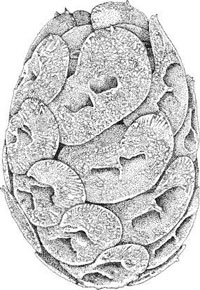Haptophyta
The great majority of Haptophyta are unicellular, motile, palmelloid, or coccoid (Figure 1.35), but a few form colonies or short filaments. These algae are generally found in marine habitats, although there are a number of records from freshwater and terrestrial environments. Flagellate cells bear two naked flagella, inserted either laterally or apically, which may have different length. A structure apparently found only in algae of this division is the haptonema, typically a long thin organelle reminiscent of a flagellum but with a different ultrastructure. The chloroplast contains only chlorophylls a, c1, and c2. The golden yellow brown appearance of the chloroplast is due to accessory pigments such as fucoxanthin, β-carotene, and other xanthins. Each chloroplast is enclosed within a fold of endoplasmic reticulum, which is continuous with the nuclear envelope. Thylakoids are stacked in threes, and there are no girdle lamellae.





